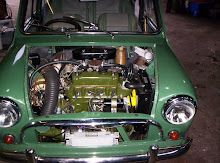The Cooper and Cooper "S" models are fitted with twin carburettors. This applies also to the majority of the increased-performance kits which are available from the tuning experts listed in Chapter 12. In order to obtain satisfactory Vjling and full power output, the throttles of both carburettors must be ex«* ly synchronized at all engine speeds and the mixture strengths of the car^ irettors must also be balanced. Adjustment is not easy, owing to the rather inaccessible mounting of the carburettors, but care taken in synchronizing the carburettors will be well repaid. Do not leave this rathe*, tricky job to an inexperienced garage mechanic. It is far better to entrust it to an experienced tuning expert if you do not feel capable of tickling the job yourself.
Bring the engine up to its normal running temperature, switch off, and remove the air cleaners. Slacken the clamping bolts on v the throttle spindle interconnecting levers, so that the throttles can be opened independently. Close both throttles fully by slackening off the.1 adjusting screws and then open each to the same extent by screwing in qach screw until it just touches its stop. Check this by seeing whether it will jVist grip a strip of thin tissue paper. Then turn each screw down to the extent of exactly one full turn.
Now remove the suction chambers and pistons after unscrewing r\hc two retaining screws on each carburettor, taking care not to bend t.hc jet needles. Check the position of the needle in each piston and cleaii the interiors of the suction chambers and the grooves of the pistons as\ des¬cribed earlier. Make sure that the springs fitted are of the correct co\our and that the needles are of the correct type (see the Appendix).
Screw each jet-adjusting nut down until the top of the jet is flush with tf bridge, or as nearly so as possible. The important point is that the positioii of the jet in relation to the bridge must be the same in each carburettor. Replace the pistons and suction chambers and check that the pistons fall freely by operating the piston lifting pins. Make sure that the piston damper wells are filled with light engine oil to within about half-an-inch of the top of the hollow piston rods.
Turn each jet-adjusting nut down by two complete turns. This is equivalent to twelve flats on each nut. It helps if a spot of cellulose paint or nail varnish is put on the outermost flat when the jets have been adjusted level with the bridges, as described earlier. The paint spots then provide an easy method of checking when each complete turn has been made. A small mirror is useful when checking the position of the marked flats on the nuts.
The engine can now be started and the idling speed adjusted to give a fairly fast tick-over by turning each throttle lever stop-screw exactly the same amount. To check the synchronization listen to the hiss at each intake by using a length of rubber tube as an improvised stethoscope, taking care to hold the end of the tube in exactly the same position on each carburettor. A child's toy stethoscope, which can be obtained from most toy shops, works even better.
There are two points to bear in mind. First, when the correct mixture strength has been obtained the idling speed may be too high and it will be necessary to unscrew each throttle lever stop-screw exactly the same amount, rechecking the intensity of the hiss at each carburettor. Secondly, although each jet adjusting nut will have been screwed down to exactly the same extent initially, it may be found, when adjustments have been completed, that the two screws are no longer exactly in step. One may be as much as one or two turns higher or lower than the other. This apparent discrepancy is well within normal variations, even with new carburettors. On older units, slight differences in the amounts of wear on the various parts can account for appreciable differences in the settings of the jet adjusting nuts.
When the adjustments have been completed, the clamping nuts on trie throttle shaft levers can be tightened; but first check that there is a clearance between the pin and the fork in the lever which is attached to the throttle spindle, when the throttle is closed. It is necessary to prevent any load from the accelerator pedal linkage being applied to the throttle butterfly and spindle.
To obtain the correct clearance, before tightening the clamping nuts place a 0-012 in. feeler gauge between the throttle shaft stop and the choke interconnecting rod. Press each throttle shaft lever downwards until its pin rests lightly on the lower arm of the fork in the carburettor throttle lever and hold it in this position while tightening the clamping bolt. When this has been done on both carburettors and the feeler gauge has been removed, each pin should have a clearance in its fork.
Connect up the mixture-control cable and make sure that the basesof the jets return against the nuts when the mixture-control knob is pushed fully home. On earlier models a certain amount of trouble was experienced owing to the control cable sticking and failing to push the jets into contact with the nuts. This causes lumpy idling and heavy fuel consumption—as much as 10 m.p.g. can be lost. It is an advantage to replace the standard mixture control cable by a low-friction type which can be obtained from one of the suppliers listed in Chapter 12. At the same time it is worthwhile to replace the accelerator cable, to give more sensitive throttle control.


0 comments:
Post a Comment